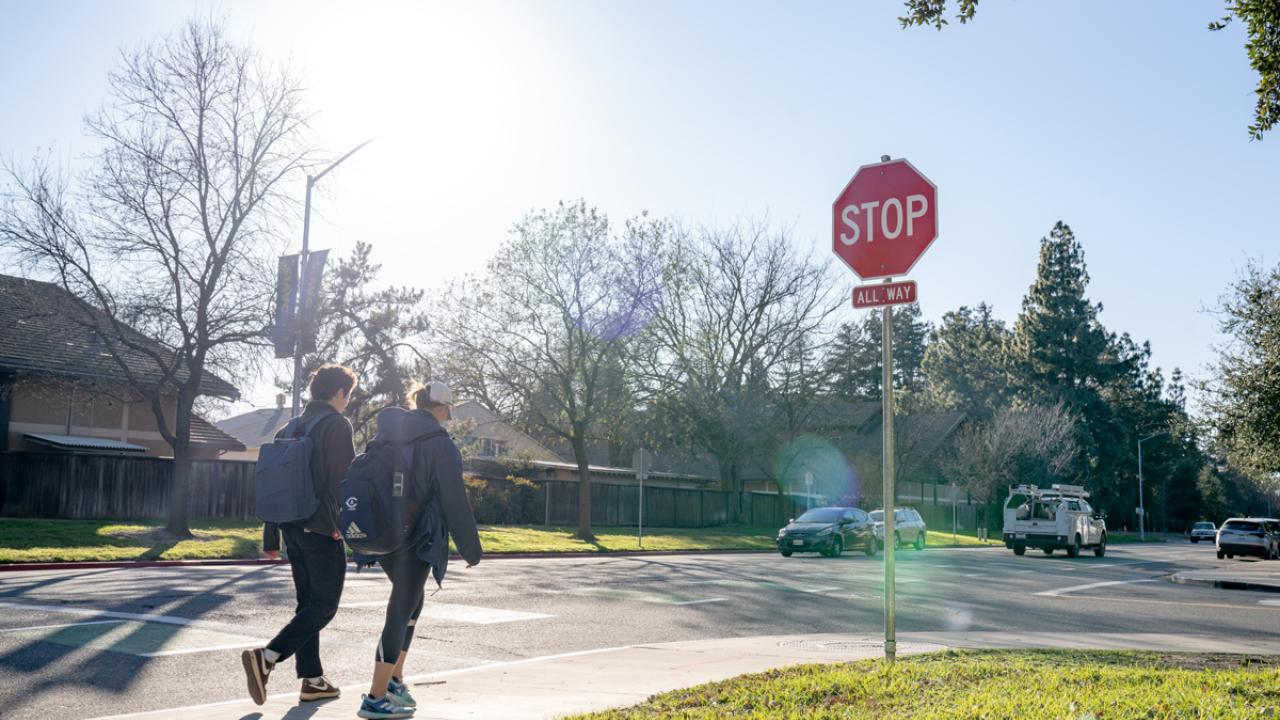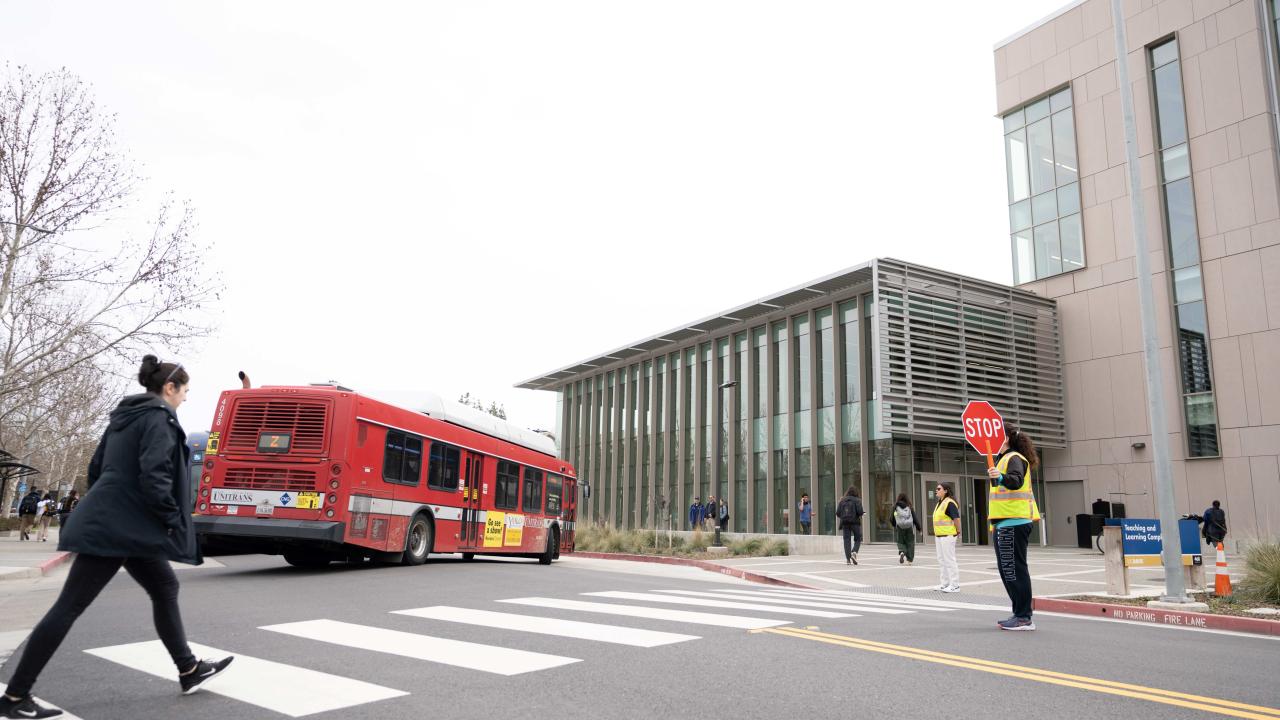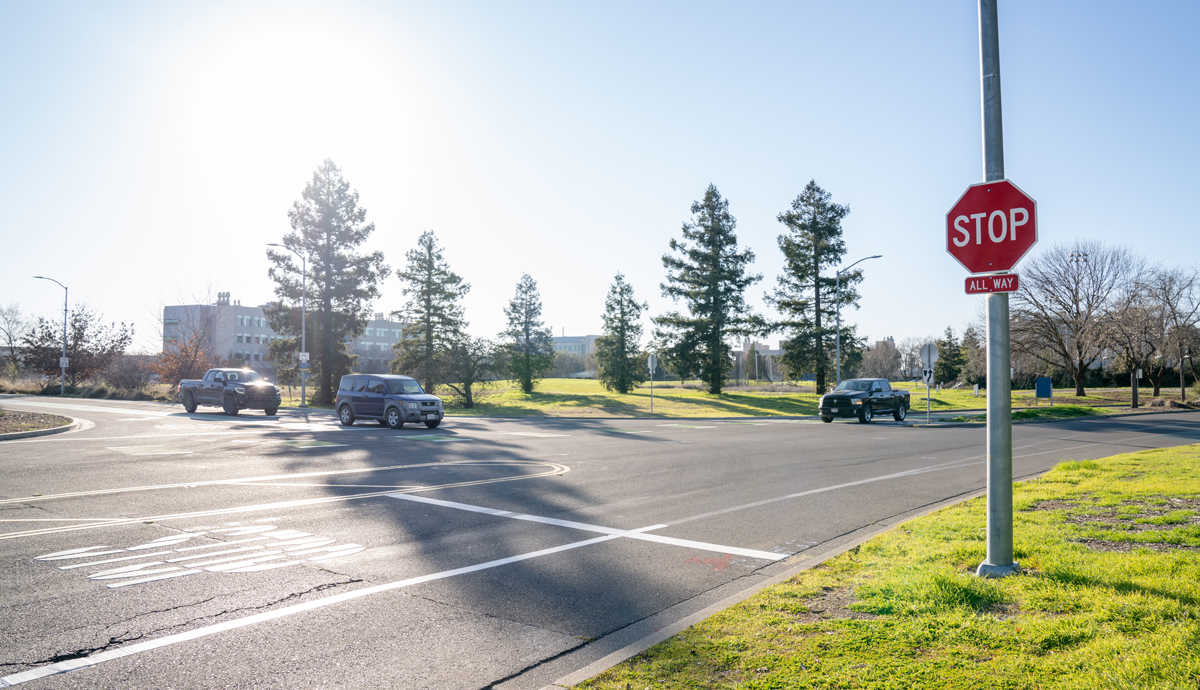
7 Ways UC Davis Is Improving Traffic Safety on Campus
Changes Aim To Eliminate Traffic Tragedies by Slowing Speeds, Increasing Visibility and Improving Awareness
UC Davis is gaining momentum on its path toward Vision Zero — a framework the campus adopted in 2024 that aims to eliminate traffic tragedies by prioritizing human life and safety over convenience.
What's Next?
These improvements are part of an ongoing effort based on recommendations from the Campus Mobility Committee, in collaboration with faculty, staff and students. The committee is focused on improving road and path safety, with representatives from Safety Services, Transportation Services, Facilities, and Design and Construction Management. The university has dedicated $20 million of funding to advance road and path safety on the Davis campus, including these and future upgrades.
Find out how to weigh in on the future of transportation on campus — Moving Forward Together.
Campus teams have been making improvements that aim to slow down traffic, increase visibility and improve awareness. Many of these changes focus on places where drivers, cyclists, scooter riders and pedestrians mix.
“Our aim is to build a campus transportation culture where everyone gets to their destination safely, first and foremost. We know human mistakes will happen, so we’re designing changes to help reduce mistakes, reduce severity of injuries and protect human lives as our top priority when it comes to transportation improvements,” said Eric Kvigne, associate vice chancellor of UC Davis Safety Services.
Here are seven updates that UC Davis has made recently to improve transportation safety:

1. Enhanced safety training for university drivers and student riders.
UC Davis requires that all drivers of university vehicles complete a “safe driver awareness” training course. The course was recently translated into Spanish. University garbage truck drivers also receive additional Cal/OSHA training for safe operation around lightweight mobility devices such as scooters and bikes. When it comes to student riders on electric bikes or scooters, student orientation sessions that address transportation safety and safety incentive programs for helmets and lights (Helmet Hair Don’t Care and Lit Not Hit) were all updated to better include students who ride e-bikes and e-scooters. Find out more about driving safely on university business.

2. Added traffic ambassadors.
To improve transportation safety near the Silo bus terminal, students trained as traffic ambassadors are now assisting with traffic flow during congested times — particularly passing periods, when thousands of pedestrians, cyclists, scooters and buses are moving through the area. Traffic ambassadors started during academic quarters Mondays through Thursdays, 9:30 a.m. to 6 p.m., after the program launched in March 2024 under the leadership of Transportation Services. Find out more about UC Davis traffic ambassadors.

3. Added 360-degree cameras to large campus vehicles.
Between 2022 and 2024, Fleet Services staff members installed 360-degree cameras on 58 large vehicles on campus — including box trucks, garbage trucks, buses, motorhomes and utility vehicles with cranes/bucket lifts. Now all large vehicles of these types in the official UC Davis fleet have 360-degree cameras, to reduce blind spots and improve visibility for their operators. All garbage trucks were also equipped with a backup alarm, strobe lights and reflective tape to provide additional visibility — and other vehicles were evaluated and equipped as necessary with similar equipment.

4. Reduced hazardous turns and heavy vehicle presence.
UC Davis policy already restricts vehicles from accessing central campus areas (or “core campus” areas) and prohibits university trucks and other vehicles from driving in the center core during passing periods (also called lockdown times). Find more details about central campus access for trucks and other vehicles. In recent years, UC Davis has been changing practices to reduce work trucks on campus in other ways. For example, Custodial Services and Solid Waste truck drivers have an earlier start time for their workday at 4:30 a.m., with the goal to be off core campus by 7:30 a.m. at the latest. Construction areas for capital projects more routinely have staging areas coordinated to minimize hazards related to construction trucks entering and exiting. Supply Chain Management is also piloting the Last Mile Initiative, which consolidates commercial deliveries so university drivers can manage deliveries and reduce the number of vehicles accessing central campus.

5. Improved sight lines.
In key locations around campus, the Grounds team took additional care to clear vegetation with pruning and other maintenance of sight lines for drivers and cyclists — particularly for intersections along La Rue Road and Hutchison Drive, including Dairy Road and Garrod Drive. To increase bike safety and visibility near Aggie Soccer Field, fence lines near the bike path intersection with Kleiber Hall Drive were adjusted to open up views for passersby without impacting the soccer field itself.

6. Restriped bike lanes on campus roadways.
In summer 2024, the maintenance team in Transportation Services repainted safety markings on many campus roadways — including updated green bike lanes along La Rue Road, which required 125 gallons of specialty “Bike Lane Green” asphalt coating. Summer weather also allowed the team to repaint crosswalks and bike lane markings throughout the campus core. The team also pressure washes thermoplastic roadway markings and is responsible for replacing damaged or fading regulatory road signs throughout the year.

7. Added stop signs.
In January, UC Davis added new stop signs to two intersections along La Rue Road to slow down traffic and increase road safety for all travelers. The stop signs turn the intersections with Garrod Drive (see photo above, near the School of Veterinary Medicine) and with Bioletti Way (near Meyer Hall) into all-way stops with supporting signage and rumble strips. The need for these improvements were identified by two micromobility task forces, who highlighted the area for high vehicle speeds. Community members shared similar concerns as part of the Moving Forward Together transportation planning activity. Find out more about these stop signs with an interactive map.
Learn more about UC Davis’ commitment to Vision Zero.